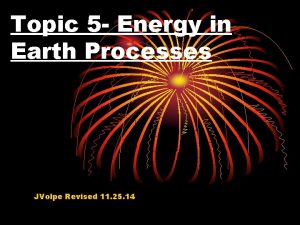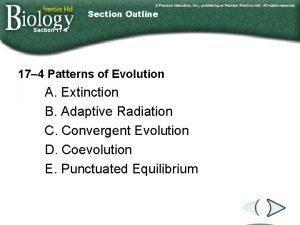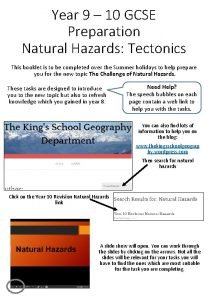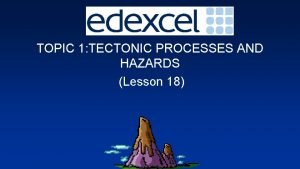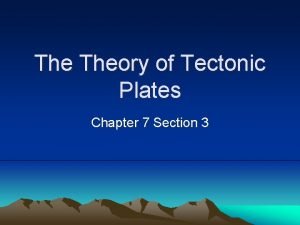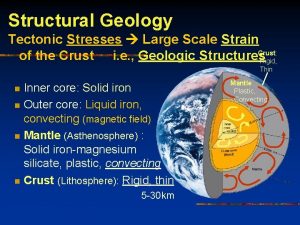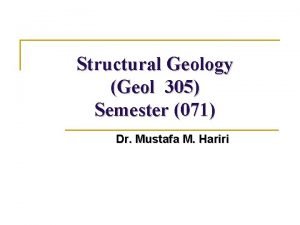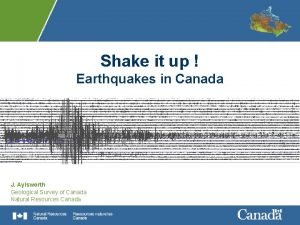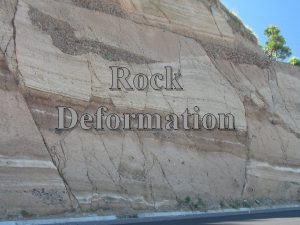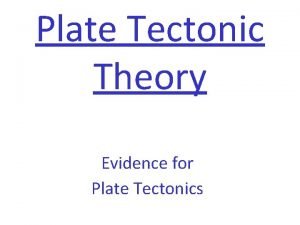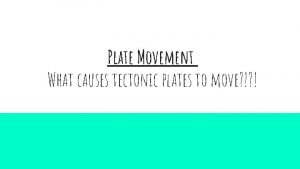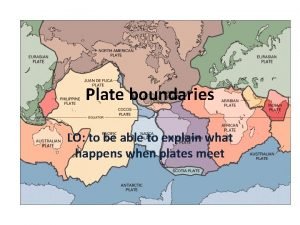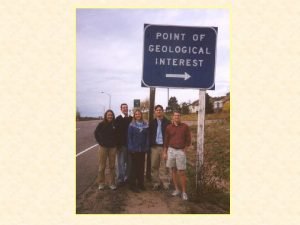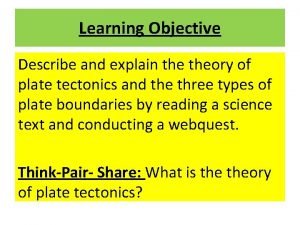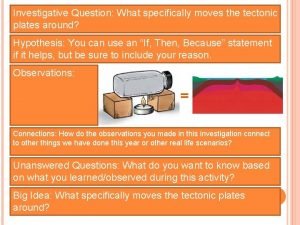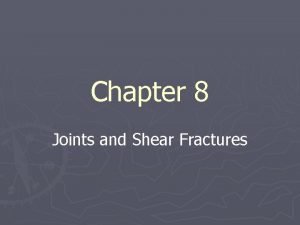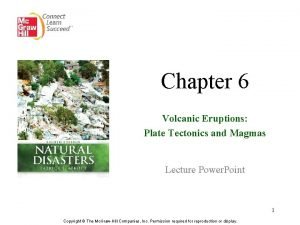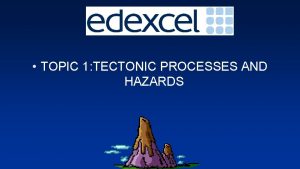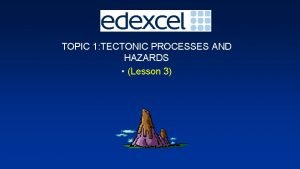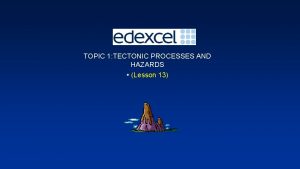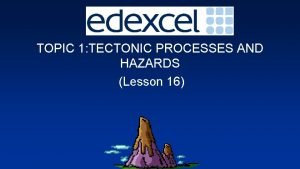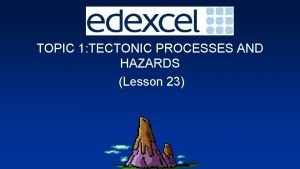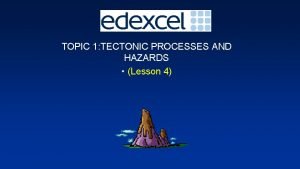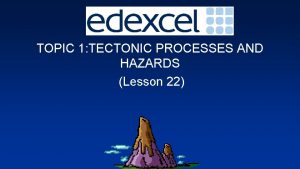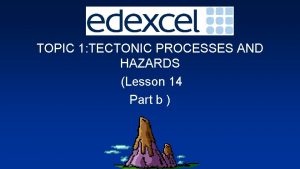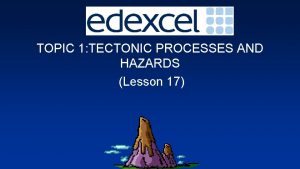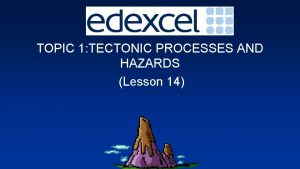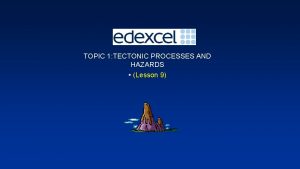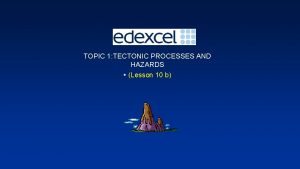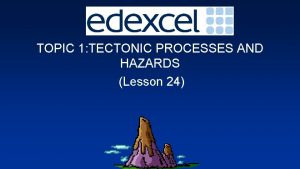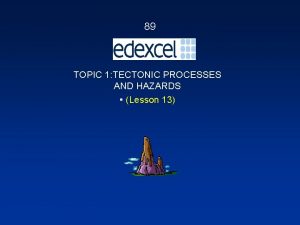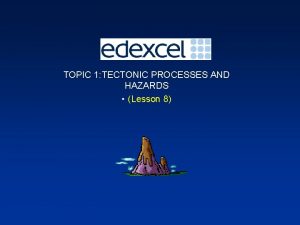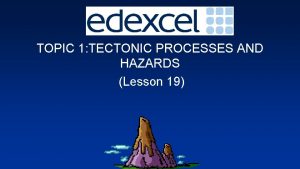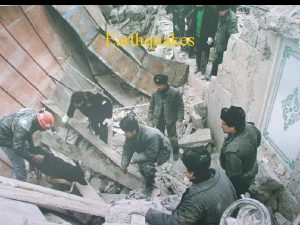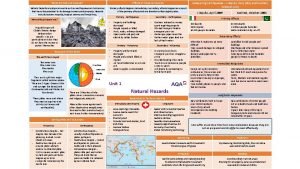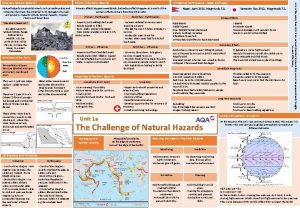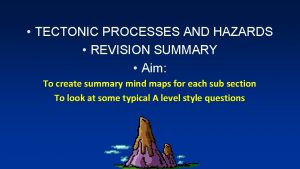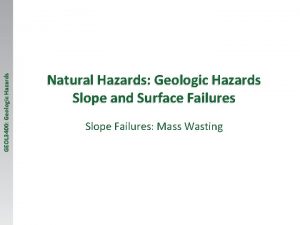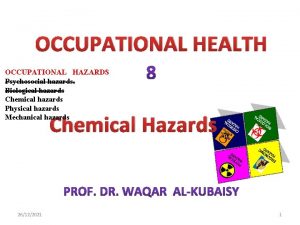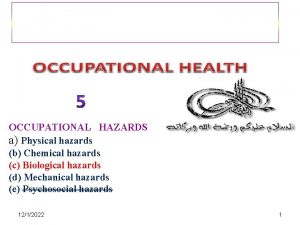TOPIC 1 TECTONIC PROCESSES AND HAZARDS Lesson 17



























- Slides: 27

TOPIC 1: TECTONIC PROCESSES AND HAZARDS (Lesson 17)

ENQUIRY QUESTION 2: • Why do some tectonic hazards develop into disasters?

Last lesson’s objectives: • To understand the Pressure and Release Model (PAR) • To be able to relate this model to specific case studies : • Haiti , Caribbean, 2010 ( developing country) • Sichuan, China, 2008 ( emerging country) • Tohoku, Japan 2011 ( developed country)

WHITEBOARD RECAP QUESTIONS • And or video clips? . . .

Today’s specification content: • 1. 5 ‘Tectonic hazard profiles are important to an understanding of contrasting hazard impacts, vulnerability and resilience. ’ • a) The magnitude and intensity of tectonic hazards is measured using different scales ( Mercalli, Moment Magnitude Scake (MMS) and Volcanic Explosivity Index(VEI) • GEOGRAPHICAL SKILLS FOR TOPIC 1: • 4) Use of correlation techniques to analyse links between magnitude of events, deaths and damage. • 5) Statistical analysis of contrasting events of similar magnitude to compare deaths and damage.

Today’s lesson objectives: • To understand how different tectonic hazards and disasters are measured using a variety of scales: • Earthquakes: Richter Scale, Moment Magnitude Scale, Mercalli scale • Volcanoes: Volcano Explosivity Index (VEI) • To recognise pros and cons of each and to be able to quote examples for each

QUICK WHITEBOARD Q. . • What was the difference between earthquake INTENSITY and MAGNITUDE?

RECAP KEY TERMS: • EARTHQUAKE INTENSITY: This is a measure of the ground shaking. It is the ground shaking that causes building damage and collapse and the loss of life from the hazard • EARTHQUAKE MAGNITUDE: This is related to the amount of movement , or displacement in the fault which in turn is a measure of energy release. It is therefore related to the strength of an earthquake and is measured at the epicentre.

MAGNITUDE AND INTENSITY SCALES • When judging the IMPACT of a tectonic disaster there a number of scales that can be used to put the events into context. • With regard to EARTHQUAKES there are TWO main scales for measuring MAGNITUDE (energy released): • 1) Richter Scale • 2) Moment Magnitude • There is also one main scale used for measuring INTENSITY( amount of damage caused): • 3) Mercalli scale • With regard to VOLCANOES one main scale is used: • Volcanic Explosivity Index (VEI)

LET’S THINK ABOUT EARTHQUAKES….

BBC Class clips- measuring earthquakes • http: //www. bbc. co. uk/learningzone/clips/understandingearthquakes-and-plate-tectonics/5724. html

There are two main ways in which we can measure earthquake magnitude: 1. The Richter Scale This measures the magnitude of a tremor (how much energy/ how powerful it is) by using the arrival times of the P and S waves, the amplitude of the S wave and the distance from the epicentre using a seismometer.

Richter Scale On the Richter Scale, magnitude is expressed in whole numbers and decimal fractions. The higher the number the greater the magnitude of the earthquake It is a logarithmic scale which means that for eg , an event measured size ‘ 6’ on the Richter Scale has amplitude of seismic waves 10 times larger than a size ’ 5’ and 100 times larger than a size ‘ 4’. The energy release is proportional to the magnitude, so that for each unit increase in scale , the energy released increases by approx 30 times. 1 2 3 4 5 6 7 8 9 10 Richter Scale

1 -2 Detected only by instruments 3 -4 Feel like vibrations from a passing lorry 5 Noticed by everyone, bells ring, trees sway and people are woken from their sleep. 6 Chimneys fall, pipes break and the ground cracks 7 -8 Only a few buildings can withstand the shaking Countryside and cities devastated, total destruction Over 8

Seismographs measure the amplitude of the seismic waves by measuring the distance between movement of the instrument and the spring which has inertia in it.

• N. B An event magnitude is usually taken from as many seismometers as possible and a mean ( average) taken • The Richter Scale is the best known form of earthquake measurement but it can be criticised for not taking different seismic waves into account!

A magnitude-8 earthquake took the sides off mountains, buried whole towns, and killed 80, 000 people in south-west China.

2. ‘The Seismic Moment Magnitude Scale’ • A new scale known as the ‘moment magnitude(Mw) was introduced in 1979. • Seismic moment is derived from the concept of ‘moment’ in physics and gives a more accurate insight into the magnitide of an earthquake ( the size of the fault rupture and accompanying slip replacement as well as the energy released. ) • However , despite the limitations of the Richter scale it is still widely used as it can be calculated rapidly and catalogues of data dating back many years are available. They are sufficient for the vast majority of observed events and the public is familiar with them.

3. The Modified Mercalli Intensity. Scale(MMI) • • • It classifies the effects ( intensity) of an earthquake using Roman Numerals from 0 –XII- in other words it measures the intensity and impact. It takes in to account the effects on the earths surface, people and buildings. The numbers are scales obtained by observing the impacts and making a judgement – NOT measured by a machine. It was first developed in 1933 and has since been modified It is therefore qualitative- not quantitative

Mercalli Scale The second way we can measure earthquakes is the Mercalli scale. This measures how much damage is caused on a scale of 1 X 11

The Mercalli scale I II III Felt by almost no one. Felt by very few people. Tremor noticed by many, but they often do not realise it is an earthquake. IV Felt indoors by many. Feels like a truck has struck the building. V Felt by everyone; many people are awakened. Swaying trees and poles may be observed. VI Felt by all; many people run outdoors. Furniture is moved. VII Everyone runs outdoors. Poorly built structures considerably damaged. Slight damage elsewhere. VII Specially designed structures damaged slightly, others collapsed. IX All buildings considerably damaged, many shift off foundations. Noticeable cracks in the ground. X Many structures destroyed. Ground badly cracked. XI Almost all structures fall. Bridges wrecked. XII Total destruction. Waves seen on ground surfaces, objects are tumbled and tossed.

Problems with MMI Deep earthquake events (>300 km) are further away from surface than shallow (<70 km) events. Thus deep events produces smaller shaking for the same size earthquake. Hence comparisons of deep and shallow events size using MMI is problematic. The response shaking of a building is affected by its natural frequencies. Hence MMI is looking at response of a building ( ie its ‘impact’)to the ground shaking not the ground shaking only. Intensity of shaking is affected by regional and near-surface geology (the soil or rock type etc. )which varies enormously. Based on subjective assessment of observations. Different people have varying perceptions of shaking; i. e. psychologically some people are more sensitive to shaking than others.

VOLCANOES!

Q: WHAT IS MEANT BY VOLCANO MAGNITUDE? ? • This refers to the size and force of volcanic eruptions. • It can VARY from gentle eruptions producing small amounts of lava to huge explosions that eject enough ash to block out the sun! • Scientists use the Volcanic Explosivity • and compare different volcanic eruptions • • Index (VEI) to describe A number is assigned to each explosion based on the volume of erupted pyroclastic material and the height of the eruption column and the magnitude of the explosion is then measured on a scale of 1 -8 It is a logarithmic scale so each increase value jumps by a factor of 10 • E. g. a VEI of 1 would indicate a gentle eruption with less than 1 million m 3 • material ejected whereas a VEI of 2 would indicate a more explosive • eruption with between 1 million to 10 million m 3 of material ejected • (SEE LATER NOTES IN ENQUIRY Q 2 ON THIS!!)

Earthquakes can be fatal but do you think that as the earthquake’s strength increases, more people will die?

Geography Skills • Do Spearman Rank activity • Investigating the relationship between the strength of an earthquake and number of deaths….

Developed v Developing/ emerging economy… • What do you think the differences of effect and recovery may be? San Fransisco - 1989 India - 2001
 Concurrent in os
Concurrent in os Broad topic and narrow topic examples
Broad topic and narrow topic examples Topic down
Topic down Parts of transverse wave
Parts of transverse wave Section 17-4 patterns of evolution
Section 17-4 patterns of evolution Patterns of evolution
Patterns of evolution Lesson 17 patterns and processes of evolution
Lesson 17 patterns and processes of evolution Primary and secondary effects of a tectonic hazard
Primary and secondary effects of a tectonic hazard Primary volcanic hazards
Primary volcanic hazards A map of the ring of fire
A map of the ring of fire Assess the importance of tectonic hazard profiles
Assess the importance of tectonic hazard profiles Continental drift theory and plate tectonics theory
Continental drift theory and plate tectonics theory What is the main cause of tectonic plate movement
What is the main cause of tectonic plate movement Tectonic joints
Tectonic joints Tectonic joints
Tectonic joints Tectonic plates canada
Tectonic plates canada Reverse fault
Reverse fault Plate tectonic theory
Plate tectonic theory Plate tectonics vs continental drift
Plate tectonics vs continental drift What causes the plates to move
What causes the plates to move Types of plate boundaries
Types of plate boundaries Converging continental plate and oceanic plate oreo
Converging continental plate and oceanic plate oreo Mount fuji tectonic plate
Mount fuji tectonic plate What is the border between two tectonic plates called
What is the border between two tectonic plates called Tectonic plates with names
Tectonic plates with names Example of an investigative question
Example of an investigative question Joints geology
Joints geology Three v's of volcanology
Three v's of volcanology



